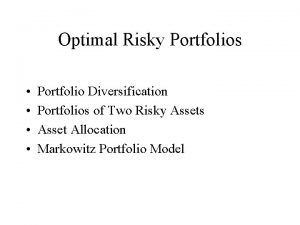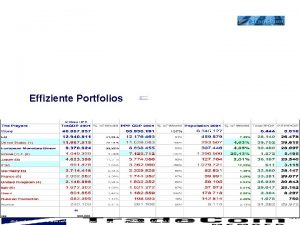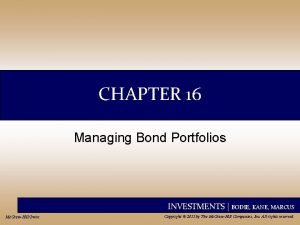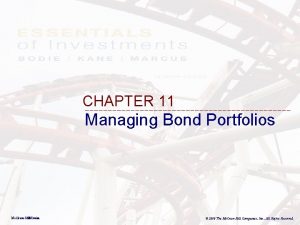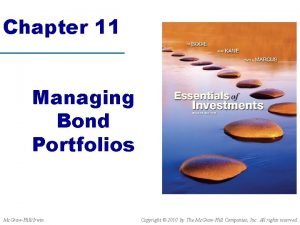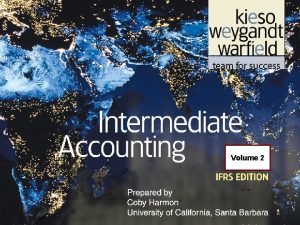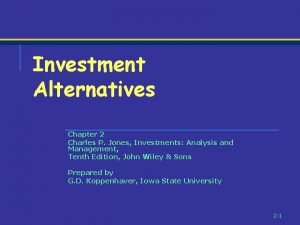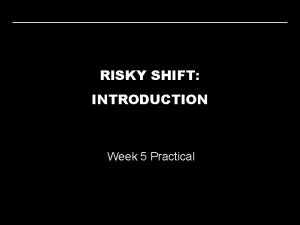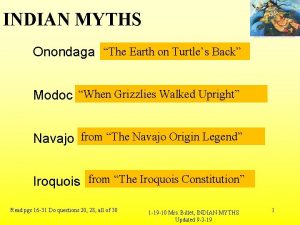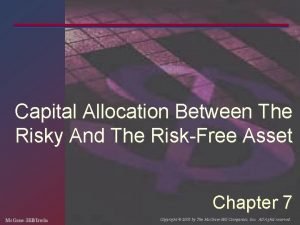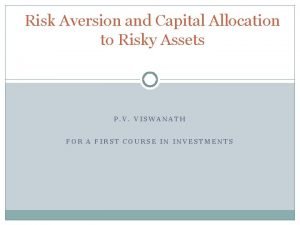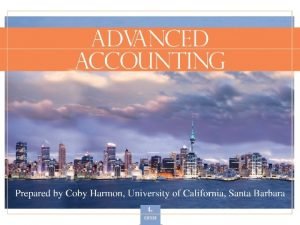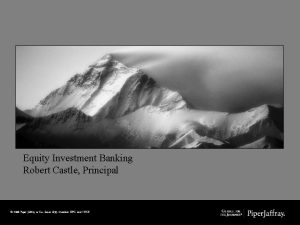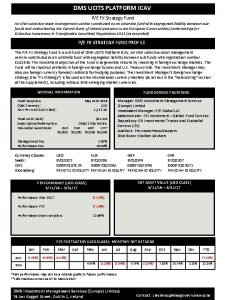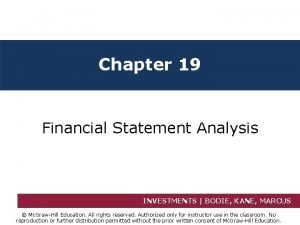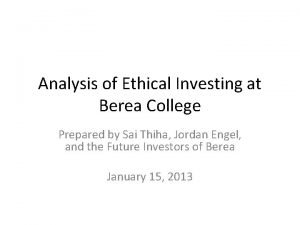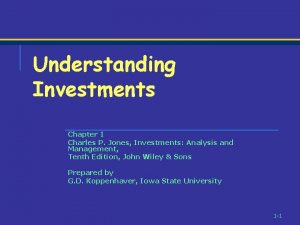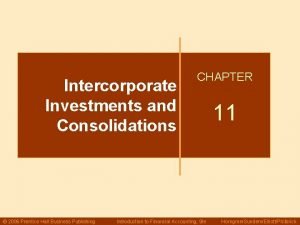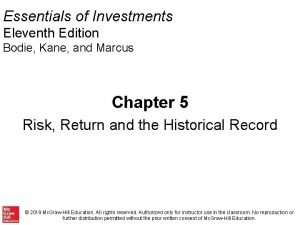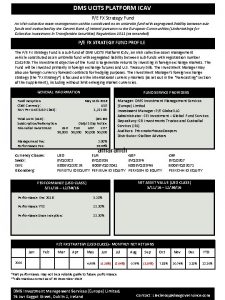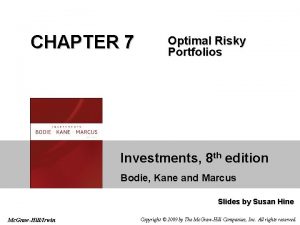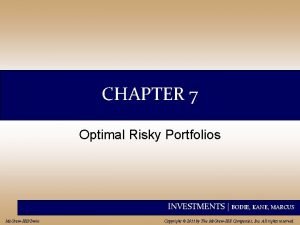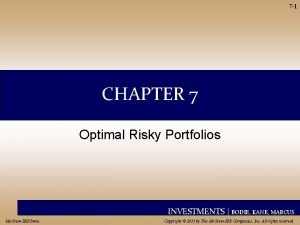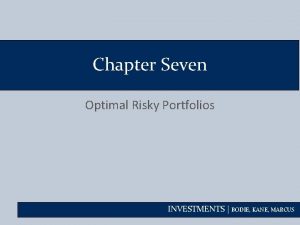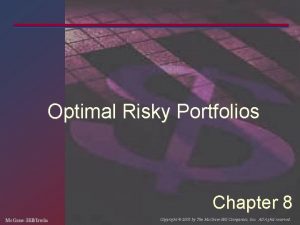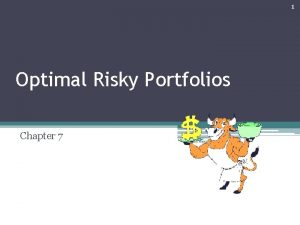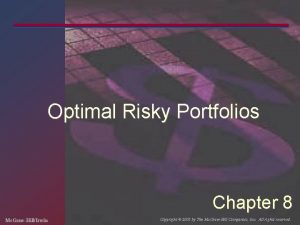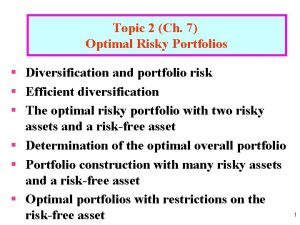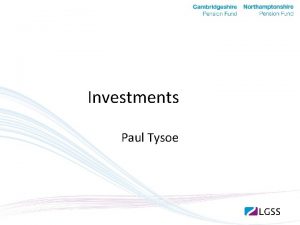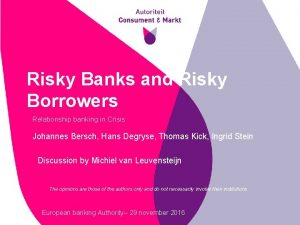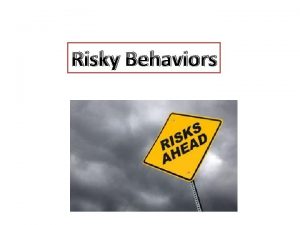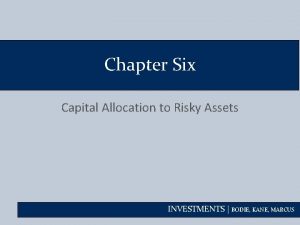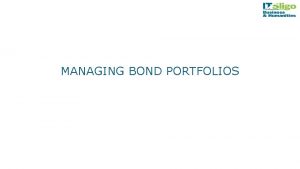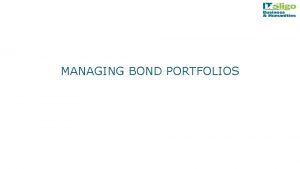CHAPTER 7 Optimal Risky Portfolios Investments 8 th






































- Slides: 38

CHAPTER 7 Optimal Risky Portfolios Investments, 8 th edition Bodie, Kane and Marcus Slides by Susan Hine Mc. Graw-Hill/Irwin Copyright © 2009 by The Mc. Graw-Hill Companies, Inc. All rights reserved.

Diversification and Portfolio Risk • Market risk – Systematic or nondiversifiable • Firm-specific risk – Diversifiable or nonsystematic 7 -2

Figure 7. 1 Portfolio Risk as a Function of the Number of Stocks in the Portfolio 7 -3

Figure 7. 2 Portfolio Diversification 7 -4

Covariance and Correlation • Portfolio risk depends on the correlation between the returns of the assets in the portfolio • Covariance and the correlation coefficient provide a measure of the way returns two assets vary 7 -5

Two-Security Portfolio: Return 7 -6

Two-Security Portfolio: Risk = Variance of Security D = Variance of Security E = Covariance of returns for Security D and Security E 7 -7

Two-Security Portfolio: Risk Continued • Another way to express variance of the portfolio: 7 -8

Covariance Cov(r. D, r. E) = DE D E D, E = Correlation coefficient of returns D = Standard deviation of returns for Security D E = Standard deviation of returns for Security E 7 -9

Correlation Coefficients: Possible Values Range of values for 1, 2 + 1. 0 > > -1. 0 If = 1. 0, the securities would be perfectly positively correlated If = - 1. 0, the securities would be perfectly negatively correlated 7 -10

Three-Security Portfolio 2 p = w 12 12 + w 22 12 + w 32 32 + 2 w 1 w 3 Cov(r 1, r 2) Cov(r 1, r 3) + 2 w 2 w 3 Cov(r 2, r 3) 7 -11

Table 7. 2 Computation of Portfolio Variance From the Covariance Matrix 7 -12

Table 7. 1 Descriptive Statistics for Two Mutual Funds 7 -13

Table 7. 3 Expected Return and Standard Deviation with Various Correlation Coefficients 7 -14

Figure 7. 3 Portfolio Expected Return as a Function of Investment Proportions 7 -15

Figure 7. 4 Portfolio Standard Deviation as a Function of Investment Proportions 7 -16

Minimum Variance Portfolio as Depicted in Figure 7. 4 • Standard deviation is smaller than that of either of the individual component assets • Figure 7. 3 and 7. 4 combined demonstrate the relationship between portfolio risk 7 -17

Figure 7. 5 Portfolio Expected Return as a Function of Standard Deviation 7 -18

Correlation Effects • The relationship depends on the correlation coefficient • -1. 0 < < +1. 0 • The smaller the correlation, the greater the risk reduction potential • If = +1. 0, no risk reduction is possible 7 -19

Figure 7. 6 The Opportunity Set of the Debt and Equity Funds and Two Feasible CALs 7 -20

The Sharpe Ratio • Maximize the slope of the CAL for any possible portfolio, p • The objective function is the slope: 7 -21

Figure 7. 7 The Opportunity Set of the Debt and Equity Funds with the Optimal CAL and the Optimal Risky Portfolio 7 -22

Figure 7. 8 Determination of the Optimal Overall Portfolio 7 -23

Figure 7. 9 The Proportions of the Optimal Overall Portfolio 7 -24

Markowitz Portfolio Selection Model • Security Selection – First step is to determine the risk-return opportunities available – All portfolios that lie on the minimumvariance frontier from the global minimumvariance portfolio and upward provide the best risk-return combinations 7 -25

Figure 7. 10 The Minimum-Variance Frontier of Risky Assets 7 -26

Markowitz Portfolio Selection Model Continued • We now search for the CAL with the highest reward-to-variability ratio 7 -27

Figure 7. 11 The Efficient Frontier of Risky Assets with the Optimal CAL 7 -28

Markowitz Portfolio Selection Model Continued • Now the individual chooses the appropriate mix between the optimal risky portfolio P and T-bills as in Figure 7. 8 7 -29

Figure 7. 12 The Efficient Portfolio Set 7 -30

Capital Allocation and the Separation Property • The separation property tells us that the portfolio choice problem may be separated into two independent tasks – Determination of the optimal risky portfolio is purely technical – Allocation of the complete portfolio to Tbills versus the risky portfolio depends on personal preference 7 -31

Figure 7. 13 Capital Allocation Lines with Various Portfolios from the Efficient Set 7 -32

The Power of Diversification • Remember: • If we define the average variance and average covariance of the securities as: • We can then express portfolio variance as: 7 -33

Table 7. 4 Risk Reduction of Equally Weighted Portfolios in Correlated and Uncorrelated Universes 7 -34

Risk Pooling, Risk Sharing and Risk in the Long Run • Consider the following: p =. 001 Loss: payout = $100, 000 No Loss: payout = 0 1 − p =. 999 7 -35

Risk Pooling and the Insurance Principle • Consider the variance of the portfolio: • It seems that selling more policies causes risk to fall • Flaw is similar to the idea that long-term stock investment is less risky 7 -36

Risk Pooling and the Insurance Principle Continued • When we combine n uncorrelated insurance policies each with an expected profit of $ , both expected total profit and SD grow in direct proportion to n: 7 -37

Risk Sharing • What does explain the insurance business? – Risk sharing or the distribution of a fixed amount of risk among many investors 7 -38
 Optimal complete portfolio formula
Optimal complete portfolio formula Activity sheet 2: stock market calculations
Activity sheet 2: stock market calculations Effizientes portfolio
Effizientes portfolio Managing bond portfolios
Managing bond portfolios Managing bond portfolios
Managing bond portfolios Managing bond portfolios
Managing bond portfolios Chapter 17 intermediate accounting
Chapter 17 intermediate accounting Intermediate accounting chapter 17 investments test bank
Intermediate accounting chapter 17 investments test bank Chapter 2 investments
Chapter 2 investments Chapter 11 real estate and other investments
Chapter 11 real estate and other investments Risky mosiac
Risky mosiac Risky shift example
Risky shift example Identify the stages of the navajo creation ceremony
Identify the stages of the navajo creation ceremony Risky adventure sports
Risky adventure sports Risky curves clothing
Risky curves clothing Pengertian pengambilan keputusan dalam kondisi beresiko
Pengertian pengambilan keputusan dalam kondisi beresiko Risky behaviour defination
Risky behaviour defination Capital allocation line
Capital allocation line Lab – discover your own risky online behavior
Lab – discover your own risky online behavior Risky sports
Risky sports What shape is the utility of a risk-averse investor?
What shape is the utility of a risk-averse investor? Equity method vs cost method
Equity method vs cost method Fundamentals of analyzing real estate investments
Fundamentals of analyzing real estate investments 02 588
02 588 Investments bodie kane marcus
Investments bodie kane marcus Loarre investments
Loarre investments Pe investments fx strategy
Pe investments fx strategy More power investments
More power investments Investments bodie kane marcus summary
Investments bodie kane marcus summary Holding a variety of investments to reduce risk
Holding a variety of investments to reduce risk Manulife
Manulife Investments berea
Investments berea Financial accounting chapter 6
Financial accounting chapter 6 Bus-123: introduction to investments
Bus-123: introduction to investments Understanding investments
Understanding investments Intercorporate investments
Intercorporate investments Intercorporate investments
Intercorporate investments Essentials of investments 11th edition
Essentials of investments 11th edition Dms investment management services
Dms investment management services
